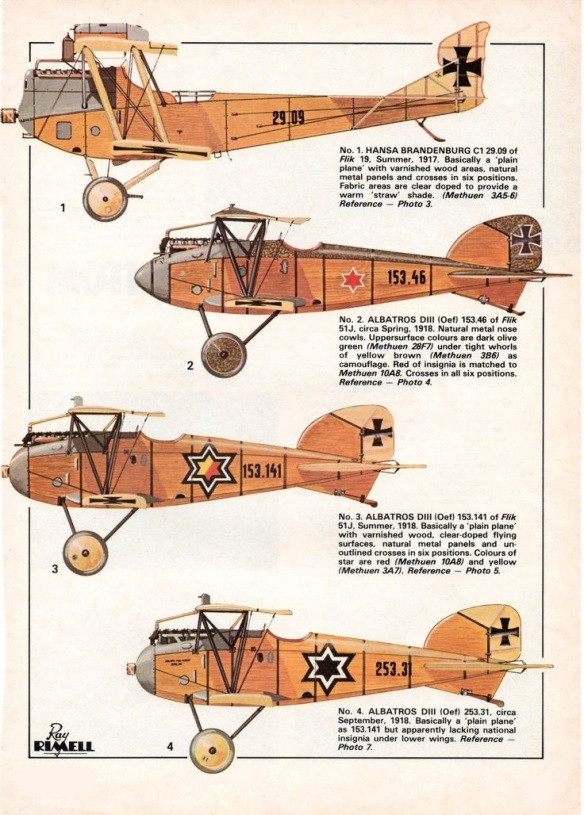The Russian collapse left the small Austro-Hungarian air service with an intensifying air war against Italy on the Southwestern Front, where it was outnumbered and confronted with Caproni attacks. Austrian battle fliers saw their first action in the tenth Battle of the Isonzo, in May and June, while the best fighter pilots, Godwin Brumowski, Julius Arigi, and Frank Linke-Crawford, continued to score as they shifted from the Hansa-Brandenburg D1 to the Austrian-built Albatros D3. For the twelfth Battle of the Isonzo, in October, 150 Austrian aircraft, reinforced by 90 German planes, including bomber units, were pitted against 320 Italian aircraft, including 85 Capronis. Though short of aircraft, the air arm fought well and routed the Italians. By the fall the air arm had grown to 66 flight companies and one G-plane squadron, only 5 units short of the planned expansion, but no company had more than 60 percent of its designated aircraft or pilot complement.
In 1917 a newly created naval aviation command had its arsenal at Pola with stations along the Adriatic coast. Naval aviator Gottfried Banfield, commander of the Trieste naval air station, fought Italian ace Francesco Baracca to a draw in his flying boat on New Year’s Day 1917, then went on to score the first night victory and attack Italian motorboat patrols. Naval aviators were forced on the defensive during the summer over the Adriatic, and the navy had to order landplanes, since flying boats could not reach the altitude of the Capronis that were striking Pola and other targets. During the Isonzo battles, Austro-Hungarian naval fliers attacked harbors and supply bases and performed reconnaissance missions over land.
In 1917 the Castiglioni conglomerate supplied the Austro-Hungarian army with C1 observation planes and D1 fighters, and the navy with CC flying boat fighters and K-boats for reconnaissance and bombing. The navy intended to rely on planes from Hansa-Brandenburg and engines from Rapp, later BMW in Munich, which Castiglioni acquired in July to increase deliveries of Porsche’s 350-hp engine. Yet the German army and navy monopolized the services of Brandenburg and BMW, with catastrophic effects on engine, and consequently K-boat, production. By fall the naval air arm had only fighters and no bombers.
As German mobilization reduced the flow of German supplies to 32 planes for the entire year, Austro-Hungarian aviation forces were forced to rely on their own limited resources and Brandenburg subsidiaries Ufag and Albatros. The Hindenburg Program prohibited the previous system of exporting aircraft frames, while the Prussian army was more reluctant to grant export permits for aircraft materials and plant machinery.
The army’s policies generally did little to solve production problems. In 1917 the aviation arsenal and a special military price commission determined that aircraft price increases were needed to keep pace with rising labor and material costs, but the War Ministry granted none because it was not assured of sufficient funds to cover raises. Such stringency impeded production and robbed the industry of the reserves accumulation necessary for postwar survival. Profit per plane in Austria-Hungary, where serial deliveries were small and production problems great, needed to exceed that in Germany, but it did not.
The deficient organization of exemptions compounded the aircraft factories’ problems in the summer of 1917. In the absence of an oft-requested central agency to distribute workers to industry, ordinary carpenters performed intricate work in the factories while skilled furniture makers and carpenters passed their time in frontline companies “making ingenious war mementoes to amuse themselves,” and large-scale-lathe hands did the precision work of turning motor cylinders while precision-lathe hands did large-scale work in metal factories.
In September the high command established a General Inspectorate to assume control of aviation in the rear from the War Ministry. In Germany the high command had granted the air force a procurement bureaucracy with some autonomy from the War Ministry. The Austro-Hungarian method of superimposing a new agency on top of the existing hierarchy was more comparable to the German high command’s superimposition of the War Office on the War Ministry in the Hindenburg Program. It yielded similar results, as the General Inspectorate merely complicated command in aviation.
In light of such rampant military and industrial inefficiency, monthly aircraft deliveries in 1917 were low and erratic. Starting at 37 aircraft in January, deliveries rose to 135 in May, plummeted to 67 in June because of strikes and shortages, peaked at 211 in August, gradually declined to 142 in November, and stopped altogether in December because of severe winter shortages. Despite this dismal ending, the industry did increase its deliveries of aircraft from 732 in 1916 to 1,272 in 1917 and of engines from 854 to 1,230.
In July, the army aviation arsenal was determined to reach 400 aircraft monthly in 1918, but could secure only 4,500 workers through October to add to the existing labor force of nearly 6,000, when it estimated needs at a grandiose and unattainable 28,000 workers. The technological prerequisites for the expansion were also lacking. German firms adamantly refused to allow the dissemination of German technical reports in Austria, Austrian factories were reluctant to exchange information, and the arsenal’s research institute did not share its proceedings with the firms. In any case, Theodore von Karman, one of the arsenal’s best scientists, was preoccupied with the development of helicopters rather than war planes.
Despite the difficulties, in the fall the AOK stipulated the production of 750 planes and 1,000 engines monthly in 1918 and further insisted on having twin-engine G-planes and armored infantry J-planes. The aviation arsenal, aware of insurmountable difficulties yet reluctant to contradict the high command, concluded that the numbers were attainable. Ultimately, the disastrous effects of the winter coal shortage in December brought the arsenal to its senses, and it revised expectations to only 125 to 200 planes monthly through April 1918. Conceding that its reach had far exceeded its grasp, the arsenal grimly prepared to face what would be the final year of the war.
